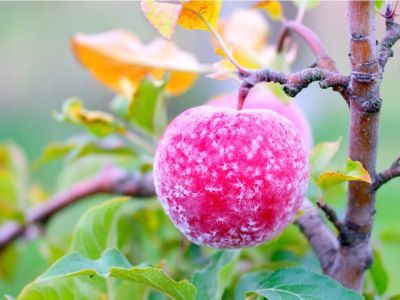There are many hardy fruit trees, but even the hardiest can be hurt by sudden drops in temperature. When they are dormant, the damage is usually minimal, but as soon as the sap starts flowing and budding begins, the tree is at its most vulnerable. Using frost shields for fruit trees can help prevent or minimize damage. How to cover fruit trees from frost? Preventing frost damage to fruit trees takes a few items and some preparation.
Fruit Trees Freezing Temperatures
Fruit tree hardiness runs the gamut depending on the variety. Most tropical trees will not withstand frost, while many pomes and stone fruits like cherries have quite a bit of ability to withstand cold temperatures. It is important to select tree species that are hardy to the gardener’s zone. This information is usually available on the plant tag. Additionally, reputable garden centers and nurseries will not sell outdoor plants that are not able to withstand the region’s temperatures. Once the buds begin to swell, however, trees are susceptible to temperatures below freezing. Their tolerance of cold diminishes as flowers and leaf buds form. If cold temperatures threaten, steps need to be taken to protect the tree and its crop.
Ways to Protect Fruit Trees from Frost
As development of leaves and fruit begins, trees are most likely to receive damage from temperatures around 20 Fahrenheit (-6.7 C). If plants are exposed to these types of cold temperatures while in bloom or just after petal shed, they can lose a significant portion of the crop. New shoots may also be damaged. A quick and easy way to prevent loss is by covering the tree if possible. Dwarf and semi dwarf trees may be draped in a sheet or lightweight blanket during the night when temperatures are below freezing. Remove the cover when temperatures are above freezing so the plant can gather solar energy for growth.
Orchard Protection from Freeze
Large scale productions or home orchards also need protection but blankets are not a sensible solution. Make sure the soil around tree roots is wet. This keeps the soil warmer than dry, frozen soil, protecting the root zone. Frost fans and overhead sprinklers that keep ice wet will help warm the area. Keep the area around trees weed free and mow any grass around them. Short grass absorbs heat during the day better than tall grass and will release it in the night to warm the area. There are also frost protection sprays available which must be applied several days prior to expected freezing temperatures. In smaller situations, burn barrels will warm the ambient air but they must be tended and are not practical in some situations.
